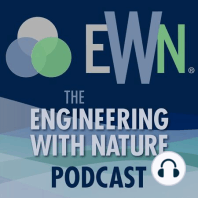2 min listen
Part 1: EWN in the Pacific Region
ratings:
Length:
31 minutes
Released:
Jul 27, 2021
Format:
Podcast episode
Description
Climate change is affecting the ecosystems that support life and everything we depend on. The United Nations declared 2021 to 2030 the ‘Decade of Ecosystem Restoration’, and there is a global effort to restore ecosystems and the many benefits they provide, from enhancing food security and safe water to biodiversity. In this episode, we're talking about the Pacific Region and how Engineering With Nature can learn from and add value to innovative ecosystem restoration, conservation, disaster management efforts, and infrastructure development. Our guests are Todd Bridges, Senior Research Scientist for Environmental Science with the U.S. Army Corps of Engineers and National Lead for EWN; Anita van Breda, Senior Director, Environment and Disaster Management, World Wildlife Fund; and William Glamore, Associate Professor and Principal Research Fellow at the Water Research Laboratory, UNSW Sydney, Australia. EWN can learn many lessons from the Pacific region in terms of its size, scale, and its diversity in nature and cultures. In the Pacific alone, there are about 25,000 islands. The Pacific Ocean covers 32% of the total surface area of the earth. The 11 Pacific Island countries that are members of the World Bank have a combined population of 2.3 million spread over 15% of the Earth’s surface. Pacific Island nations are facing critical challenges from climate change and sea level rise. The Pacific and Indian Oceans together cover almost half the surface area of the earth. If you add Asia, which is the largest continent, most of the world is in the Pacific and Asian region. Australia itself is a huge island continent. As Will points out, the coastline of one Australian state is equivalent to the entire U.S. East and West Coasts combined! It’s a land of extremes with searing heat, long droughts broken up by major floods, and waves of cold Antarctic blasts. Climate change is further compounding these effects, and the impacts are being felt through massive coral bleaching of the Great Barrier Reef, disastrous wildfires along the East Coast, and other large-scale climate effects. As Anita notes, “The Pacific people have a strong attachment to land, not just as an economic commodity, but as a strong tie to their history and culture, their sense of who they are as a people. This presents a unique opportunity to use natural and nature-based features and the services they provide for local communities.” She adds, “Nature is such a fundamental part of who we are as people. Even at the smallest scale of the individual household level, it is a powerful thing. We should include that when we think about tackling big, systemic problems at landscape-level scale.” As Todd describes it, “There's tremendous diversity in context physically, but also culturally, that dwarfs the landscape and cultural diversity we have in North America or even in Europe. So how do we, consistent with Engineering With Nature, follow Mother Nature's lead in composing solutions for these challenges rather than trying to impose and control Mother Nature with completely artificial solutions?” Will notes that when Europeans settled Australasia and the Pacific, they applied a Eurocentric, one-size-fits-all view of the world. “Today I sit at the same desk as people who, 50 or 60 years ago, built the traditional dams, dykes, levees and canals. Now I’m trying to de-engineer those structures and make them more effectively engineered with nature.” He describes his early work as a PhD student faced with the challenge of acidic floodplains and how nature-based solutions were needed to solve the problem at scale. While this initial research helped solve the acid problem, he also quickly realized that it provided co-benefits of improved water quality, reduced flood risk, increased aquaculture, and blue carbon habitat. In this podcast, Will describes how his EcoEng team has grown this research from small test sites to huge scale creation projects and how he is now trying to crea
Released:
Jul 27, 2021
Format:
Podcast episode
Titles in the series (82)
Engineering With Nature - EWN: Over the last 10 years, the U.S. Army Corps of Engineers has been working on an initiative called Engineering With Nature that uses natural processes and systems to deliver a broad range of economic, environmental, and social benefits. EWN, as... by EWN - Engineering With Nature
